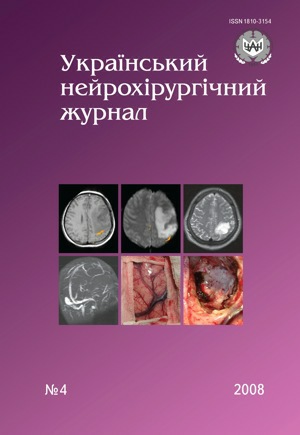The significance of brain acoustic evoked potentials method for differential diagnosis at injured persons with fractures of temporal bone petrosal pyramid in the acute period of craniocerebral trauma
DOI:
https://doi.org/10.25305/unj.108362Keywords:
head injury, fracture of petrous, the acute period, stem acoustic evoked potentials.Abstract
Results of 59 young and middle-aged injured persons examination with fractures of the temporal bone pyramid in the acute period of craniocerebral trauma using brain acoustic evoked potentials (BAEP) method are presented. Regularity of BAEP parameters changes depending on the localization of temporal bone pyramid fracture has been elicited. The objective estimate of brain structures functional state changes was made while the severity of cerebral trauma was determined according to the data of neurovisualizing methods. It allowed to evaluate more objectively the severity of clinical course and outcome of the disease. The possibilities of BEAP method for objective evaluation of VIII pair of cranial nerves impairment at victims with temporal bone pyramid fractures in the acute period of craniocerebral trauma have been determined.
References
Алексанов Н.С., Щиголев Ю.С., Гизатуллин Ш.Х. Коротколатентные слуховые вызванные потенциалы у больных с сотрясением головного мозга // Вопр. нейрохирургии. — 1995. — Вып.2. — С.17–20.
Благовещенская Н.С. Отоневрологические симптомы и синдромы. — М.: Медицина, 1990. — 256 с.
Зенков Л.Р., Ронкин М.А. Функциональная диагностика нервных болезней: Руководство для врачей. — М.: Медицина, 2004. — 260 с.
Куксова Н.С., Сумский Л.И. Диагностические возможности метода стволового акустического вызванного потенциала в нейрохирургической клинике // Нейрохирургия. — 2007. — №2. — С.37–42.
Пудов А.И., Терещук Т.И., Евстратова Л.И. Коротколатентные слуховые вызванные потенциалы при некоторых патологических состояниях мозга // Вопр. нейрохирургии. — 1986. — Вып.4. — С.39–43.
Таварткиладзе Г.А. Проблемы нейрокибернетики // Междунар. конф., 12-я: Тез. — Ростов-н-Д., 1999. — С.291–293.
Томас Дж., Потапов А.А., Шекутаев Г.А. Коротколатентные слуховые вызванные потенциалы в оценке тяжести и локализации травматических повреждений головного мозга // Вопр. нейрохирургии. — 1985. — Вып.5. — С.36–41.
Freye E. Cerebral monitoring in the operating room and the intensive care unit — an introductory for the clinician and a guide for the novice wanting to open a window to the brain. Part II: Sensory-evoked potentials (SSEP, AEP, VEP) // J. Clin. Monit. Comput. — 2005. — V.19, N1–2. — P.77–168.
Keith H., Chiappa M.D. Evoked Potentials in Clinical Medicine. — 1997.
Kuttner K., Bauer F., Knupper P. Diagnostic value of the early auditory evoked potentials in acute cranio-cerebral trauma in children // Kinderarztl. Prax. — 1990. — Bd.58, H.1. — S.37–43.
Markand O.N. Brainstem auditory evoked potentials // Clin. Neurophysiol. — 1994. — V.11. — P.319–342.
Rogowski M., Michalska B.I. The importance of brain stem evoked potentials in the diagnosis of neurosurgical patients // Neurol. Neurochir. Pol. — 2001. — V.35, N4. — P.667–679.
Rogowski M., Michalska B.I., Lewko J. et al. Correlation of brain stem evoked response audiometry (BERA) with Glasgow Coma Scale (GCS) and Glasgow Outcome Scale (GOS) // Neurol. Neurochir. Pol. — 2003. — V.37, N3. — P.601–610.
Schoenhuber R., Gentili M. Brainstem auditory potentials after minor head trauma // Neurochirurgia. — 1987. — V.30, N4. — P.115–118.
Stanca A., Santini A., Oliva A. et al. Auditory evoked potentials of the brain stem in brain injury. Prognostic value // Minerva Anesthesiol. — 1990. — V.56. — P.95–97.
Downloads
Published
How to Cite
Issue
Section
License
Copyright (c) 2008 O. E. Skobska, A. I. Tretyakova

This work is licensed under a Creative Commons Attribution 4.0 International License.
Ukrainian Neurosurgical Journal abides by the CREATIVE COMMONS copyright rights and permissions for open access journals.
Authors, who are published in this Journal, agree to the following conditions:
1. The authors reserve the right to authorship of the work and pass the first publication right of this work to the Journal under the terms of Creative Commons Attribution License, which allows others to freely distribute the published research with the obligatory reference to the authors of the original work and the first publication of the work in this Journal.
2. The authors have the right to conclude separate supplement agreements that relate to non-exclusive work distribution in the form of which it has been published by the Journal (for example, to upload the work to the online storage of the Journal or publish it as part of a monograph), provided that the reference to the first publication of the work in this Journal is included.









